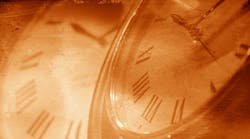The U.S. government continues to claim that Daylight Saving Time (DST) saves the country energy. And while some studies show a small drop, less than 0.5% of electrical use, the overall energy demand actually jumps by 4%, according to recent Dept. of Energy study.
With the extra daylight from DST, people tend to do more things—go to the park, golf, or shop—and Americans being American, they drive to get to those events. That’s why the fuel industry lobbied to reintroduce DST after two short-term experiments using DST to “save” energy during World Wars One and Two. The fuel industry knows full well that DST has led to higher gas consumption.
Similarly, the people who own golf courses say that the additional month of daylight translates into $400 million more dollars in revenues. The barbecue grill and charcoal business groups also notice a bump in sales during the extra month of sun—$200 million.
That last time DST was extended, going from seven to eight months in 2005, the change was part of the Energy Policy Act. But the extension had nothing to do with energy, according to Michael Downing, author of Spring Forward, The Annual Madness of Daylight Savings Time. He says the National Assoc. of Convenience Stores pushed hard for the change because it wanted Halloween to fall during DST. It would give kids more time to collect candy, which many people buy at convenience stores. The association also knows that about 80% of Americans buy gas at convenience stores, and it calculates that the extra hour of daylight translates into a $1 billion increase in sales.
Electric utilities say the extra light of DST, which now stretches eight months, does lower the amount of electricity that goes for powering indoor lighting, but that’s more than offset by higher use of air conditioning at offices, factories, and shopping malls.
Another DST myth is that the practice was established to help the farmers. In fact, farmers strongly resisted DST because it gave them an hour less time to get crops in and to market. They used their lobbying power to stave it off until 1966 when their numbers and influence shrunk and President Johnson then signed the legislation.
DST also affects Amtrak trains. When we turn our clocks back an hour in October, any Amtrak train running on time stops at 2:00 a.m. and waits an hour before getting underway again. This keeps the trains on time, according to Amtrak. Passengers on these stopped trains get to enjoy the local night-time scenery and an extra hour of travel time. Why the trains can’t keep chugging along and at least stop at the nearest station, thus delivering some passengers and cargo early, is an Amtrak mystery. In the spring, when clocks go back at 2 am, trains instantaneously become an hour behind schedule. They then struggle to make up the lost hour.
A minor but persistent DST myth: It was first proposed by Benjamin Franklin. While Franklin talked about a time shifting scheme that would give Parisians more daylight to enjoy themselves, he was being satirical. In fact, the first serious proposal came from George Vernon Hudson of New Zealand in 1895. He was an entomologist (a scientist who studies insects). Shifting the clock would let him do his insect collecting in the daylight.
